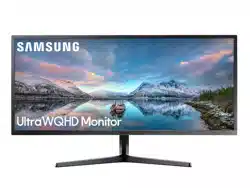Documents: Go to download!
- Owner's manual - (English)
- Chapter 01 Before Using the Product
- Chapter 02 Preparations
- Chapter 03 Connecting and Using a Source Device
- Chapter 04 Screen Setup
- Chapter 05 Configuring the PIP/PBP Settings
- Chapter 06 Adjusting OSD (On Screen Display) settings
- Chapter 07 Setup and Reset
- Chapter 08 Installing the Software
- Chapter 09 Troubleshooting Guide
- Q & A
Table of contents
User manual Monitor
Chapter 01 Before Using the Product
Electricity and Safety
Warning
- Do not use a damaged power cord or plug, or a loose power socket.
- Do not use multiple products with a single power socket.
- Do not touch the power plug with wet hands.
- Insert the power plug all the way in so it is not loose.
- Connect the power plug to a grounded power socket (type 1 insulated devices only).
- Do not bend or pull the power cord with force. Be careful not to leave the power cord under a heavy object.
- Do not place the power cord or product near heat sources.
- Clean any dust around the pins of the power plug or the power socket with a dry cloth.
Caution
- Do not disconnect the power cord while the product is being used.
- Only use the power cord provided with your product by Samsung. Do not use the power cord with other products.
- Keep the power socket where the power cord is connected unobstructed. The power cord must be disconnected to cut off power to the product when an issue occurs.
- Hold the plug when disconnecting the power cord from the power socket.
Chapter 02 Preparations
Control Panel
The color and shape of parts may differ from what is shown. Specifications are subject to change without notice to improve quality.

JOG Button
Multi directional button that helps navigate.
― The JOG button is located on the rear left side of the product. The button can be used to move up, down, left or right, or as Enter.
Power LED
This LED is power status indicator and works as
• Power On (Power button): Off
• Power saving mode: Blinking
• Power Off (Power button): On
― The power Indicator operation can be swapped by changing in the menu. (System → Power LED On) Actual models because of functional variation maybe haven’t this function.
Function Key Guide
Press the JOG button when the screen is turned on. The Function Key Guide will appear. To access the onscreen menu when the guide is displayed, press the corresponding direction button again.
― Function Key Guide may vary depending on the function or product model. Please refer to the actual product.
Direct Key guide
― The shortcut button screen (OSD menu) shown below is displayed only when the monitor screen is turned on, the computer resolution changes, or the input source changes.
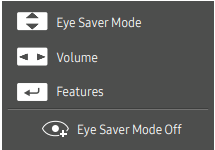
• UP/DOWN: Adjust Brightness, Contrast, Eye Saver Mode.
• LEFT/RIGHT: Adjust Volume.
• PRESS(ENTER): Display Function Key Guide.
Function Key Guide
― To enter the main menu or to use other items, press the JOG button to display the Function Key Guide. You can exit by pressing the JOG button again.
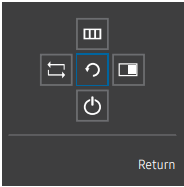
UP/DOWN/LEFT/RIGHT: Move to the item you want. The description for each item will appear when the focus changes. PRESS(ENTER): The selected item will be applied.

Selects  to change the input signal by moving the JOG button in the Function Key Guide screen. A message will appear on the top left corner of the screen if the input signal has been changed.
to change the input signal by moving the JOG button in the Function Key Guide screen. A message will appear on the top left corner of the screen if the input signal has been changed.

Selects  by moving the JOG button in the function key guide screen.
by moving the JOG button in the function key guide screen.
The OSD (On Screen Display) of your Monitor’s feature appears.
OSD control lock: Maintain the current settings, or lock the OSD control to prevent unintended changes to settings.
Enable/Disable: To lock/unlock the OSD control, press the LEFT button for 10 seconds when the main menu displayed.
― If the OSD control is locked, Brightness and Contrast can be adjusted. PIP/PBP is available. Eye Saver Mode is available. Information can be viewed.

Selects  by moving the JOG button in the function key guide screen.
by moving the JOG button in the function key guide screen.
Press the button when configuring settings for the PIP/PBP function is required.

Selects  to turn the Monitor off by moving the JOG button in the function key guide screen.
to turn the Monitor off by moving the JOG button in the function key guide screen.
Configuring Eye Saver Mode, Brightness and Contrast from the Initial Screen
Adjust the Brightness, Contrast and Eye Saver Mode by moving the JOG button.

― The displayed image may differ depending on the model.
― The default brightness can vary depending on the region.
Eye Saver Mode
― Not available when PIP/PBP Mode is set to On.
Brightness
― This menu is not available when SAMSUNG MAGICBright is set to Dynamic Contrast mode.
― This menu is not available when Eco Saving Plus is enabled.
― This menu is not available when Eye Saver Mode is enabled.
Contrast
― This menu is not available when SAMSUNG MAGICBright is in Cinema or Dynamic Contrast mode.
― This menu is not available when Game Mode is enabled.
― This menu is not available when PIP/PBP Mode is set to On and the Size is set to  (PBP Mode).
(PBP Mode).
Changing the Volume setting
You can adjust Volume by moving the JOG button left or right, if no OSD menu is displayed.

― The displayed image may differ depending on the model.
― If the audio quality of a connected input device is poor, the Auto Mute function on the product may mute the sound or cause choppy audio when applying the headphones or speakers. Set the input volume for the input device to at least 20% and control the volume using the volume control (JOG button LEFT/RIGHT) on the product.
― What is Auto Mute? The function mutes the audio to improve sound effect when there is sound noise or when the input signal is weak, usually due to a problem with the volume of an input device.
― To activate the Mute function, access the Volume control screen, then use the JOG button to move the focus down. To deactivate the Mute function, access the Volume control screen, then increase or decrease the Volume.
Anti-theft Lock
― An anti-theft lock allows you to use the product securely even in public places.
― The locking device shape and locking method depend on the manufacturer. Refer to the user guide provided with your anti-theft locking device for details.
To lock an anti-theft locking device:
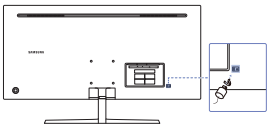
1 Fix the cable of your anti-theft locking device to a heavy object such as a desk.
2 Put one end of the cable through the loop on the other end.
3 Insert the locking device into the anti-theft lock slot at the back of the product.
4 Lock the locking device.
‒ An anti-theft locking device can be purchased separately.
‒ Refer to the user guide provided with your anti-theft locking device for details.
‒ Anti-theft locking devices can be purchased at electronics retailers or online.
Installing a Wall-mount Kit or Desktop Stand
― Power the product off and remove the power cable from the power socket.

A Attach the wall-mount kit or desktop stand here.
B Attach the INLAY to the position as shown in the figure.
C Bracket (sold separately)
Align the grooves and tightly fasten the screws on the bracket on the product with the corresponding parts on the wall-mount kit or desktop stand you want to attach.
Notes
- Using a screw longer than the standard length can damage the internal components of the product.
- The length of screws required for a wall mount that does not comply with the VESA standards may vary depending on the specifications.
- Do not use screws that do not comply with the VESA standards. Do not attach the wall-mount kit or desktop stand using excessive force. The product may get damaged or fall and cause personal injury. Samsung shall not be held liable for any damage or injury caused by using improper screws or attaching the wall-mount kit or desktop stand using excessive force.
- Samsung shall not be held liable for any product damage or personal injury caused by using a wall-mount kit other than the one specified or from an attempt to install the wall-mount kit on your own.
- To mount the product on a wall, ensure you purchase a wall-mount kit that can be installed 10 cm or farther away from the wall.
- Be sure to use a wall-mount kit that complies with the standards.
- To install the monitor using a wall mount, disconnect the stand base from the monitor.

Do not install your Wall Mount Kit while your product is turned on. It may result in personal injury due to electric shock.
Installation
Attaching the Stand
- Before assembling the product, place the product down on a flat and stable surface so that the screen is facing downwards.
- The exterior may differ depending on the product.

Insert the stand neck into the stand base in the direction shown in the figure. Check that the stand neck is firmly connected.
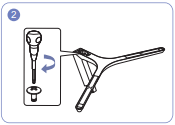
Tightly fasten the connecting screw at the bottom of the stand base.
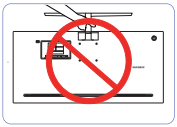
Caution Do not hold the product upside down only by the stand.
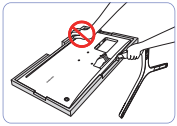
Caution Do not press down on the monitor. There is a risk of damaging the monitor.
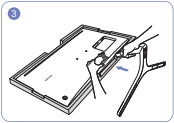
Place the protective Styrofoam (cushion) included in the package on the floor and place the product facing down on the Styrofoam, as shown in the image. If Styrofoam is unavailable, use a thick sitting mat. Hold the back of the monitor as shown in the figure. Push the assembled stand into the main body in the direction of the arrow as shown in the figure.
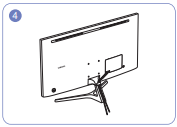
Connect the power supply and the data cable as shown in the figure.
Removing the Stand
― Before removing the stand from the monitor, place the monitor on a flat and stable surface with the screen facing down.
― The exterior may differ depending on the product.

Place the protective Styrofoam (cushion) included in the package on the floor and place the product facing down on the Styrofoam, as shown in the image. If Styrofoam is unavailable, use a thick sitting mat. While holding the monitor with one hand, pull the stand neck with your other hand to in detach the stand as shown in the figure.

Turn the connecting screw at the bottom of the stand base to separate it.

Remove the stand neck from the stand base by pulling it in the direction of the arrow as shown in the figure.
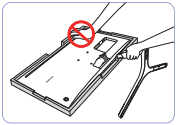
Caution Do not press down on the monitor. There is a risk of damaging the monitor.
Chapter 03 Connecting and Using a Source Device
Read below before installing the monitor.
- Check the shapes of both ends of the cables that came with the monitor, and check the shapes and positions of the matching ports on the monitor and external devices.
- Before connecting signal cables, disconnect the power cables for the monitor and external devices from the power outlet to prevent device damage from a short circuit or overcurrent.
- After connecting all signal cables, connect the power cables for the monitor and external devices to the power outlet.
- Read the user manual to familiarize yourself with the monitor functions, precautions, and proper use, before using the installed monitor.
Connecting and Using a PC
Select a connection method suitable for your PC.
― Connecting parts may differ in different products.
― Provided ports may vary depending on the product.
Connection Using the HDMI Cable
Check to make sure that the power cables for the monitor and external devices, such as computers and set-top boxes, are not connected to the power outlet.
― To display 3440 x 1440 @ 50 Hz, use an HDMI cable that supports 3440 x 1440 @ 50 Hz to connect HDMI1. Make sure that the graphics card of the HDMI source supports 3440 x 1440 @ 50 Hz.
― To display 3440 x 1440 @ 75 Hz, use an HDMI cable that supports 3440 x 1440 @ 75 Hz to connect HDMI2. Make sure that the graphics card of the HDMI source supports 3440 x 1440 @ 75 Hz.
― When connecting an HDMI cable, use the cable that came with the components of the monitor. If you use an HDMI cable other than provided by Samsung, the image quality may be degraded.
Connection Using the HDMI-DVI Cable
Check to make sure that the power cables for the monitor and external devices, such as computers and set-top boxes, are not connected to the power outlet.

― The audio function is not supported if the source device is connected using the HDMI-DVI cable.
― The optimum resolution may not be available with an HDMI-DVI cable.
Connection Using the DP Cable
Check to make sure that the power cables for the monitor and external devices, such as computers and set-top boxes, are not connected to the power outlet.

― To display 3440 x 1440 @ 75 Hz, use a DP cable that supports 3440 x 1440 @ 75 Hz. Make sure that the graphics card of the DP source supports 3440 x 1440 @ 75 Hz.
Connecting to Headphones

― Use headphones when activating sound with an HDMI-HDMI or DP cable.
― The earphone jack supports only the 3 conductor tip-ring-sleeve (TRS) type.
Connecting the Power
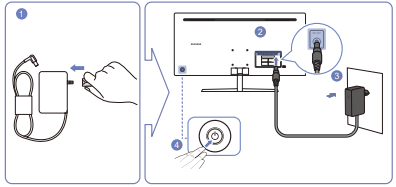
1 Connect the power plug to the AC/DC adapter.
2 Connect the AC/DC adapter cable to the DC 19V port on the back of the monitor.
3 Plug the AC/DC adapter into the power outlet.
4 Press the JOG button on the back of the monitor to turn it on.
― The input voltage is switched automatically
Chapter 04 Screen Setup
― The functions available may vary depending on the product model. The color and shape of parts may differ from what is shown. Specifications are subject to change without notice to improve quality
SAMSUNG MAGIC Bright
This menu provides an optimum picture quality suitable for the environment where the product will be used.
- This menu is not available when Eco Saving Plus is enabled.
- This menu is not available when Game Mode is enabled.
- This menu is not available when Eye Saver Mode is enabled.
- Not available when PIP/PBP Mode is set to On.
You can customize the brightness to suit your preferences.
In PC mode
- Custom: Customize the contrast and brightness as required.
- Standard: Obtain a picture quality suitable for editing documents or using Internet.
- Cinema: Obtain the brightness and sharpness of TVs suitable for enjoying video and DVD content.
- Dynamic Contrast: Obtain balanced brightness through automatic contrast adjustment.
In AV mode
When the external input is connected through HDMI/DP and PC/AV Mode is set to AV,  has four automatic picture settings (Dynamic, Standard, Movie and Custom) that are preset at the factory. You can activate either Dynamic, Standard, Movie or Custom. You can select Custom which automatically recalls your personalized picture settings.
has four automatic picture settings (Dynamic, Standard, Movie and Custom) that are preset at the factory. You can activate either Dynamic, Standard, Movie or Custom. You can select Custom which automatically recalls your personalized picture settings.
- Dynamic: Select this mode to view a sharper image than in Standard mode.
- Standard: Select this mode when the surroundings are bright. This also provides a sharp image.
- Movie: Select this mode when the surroundings are dark. This will save power and reduce eye fatigue.
- Custom: Select this mode when you want to adjust the image according to your preferences.
Brightness
You can adjust the general brightness of the picture. (Range: 0~100)
A higher value will make the picture appear brighter.
- This menu is not available when
 is set to Dynamic Contrast mode.
is set to Dynamic Contrast mode. - This menu is not available when Eco Saving Plus is enabled.
- This menu is not available when Eye Saver Mode is enabled.
Contrast
Adjust the contrast between the objects and background. (Range: 0~100)
A higher value will increase the contrast to make the object appear clearer.
- This option is not available when
 is in Cinema or Dynamic Contrast mode.
is in Cinema or Dynamic Contrast mode. - This menu is not available when Game Mode is enabled.
- This menu is not available when PIP/PBP Mode is set to On and the Size is set to
 (PBP Mode).
(PBP Mode). - This menu is not available when Eye Saver Mode is enabled.
Sharpness
Make the outline of objects more clear or blurry. (Range: 0~100)
A higher value will make the outline of objects clearer.
- This option is not available when
 is in Cinema or Dynamic Contrast mode.
is in Cinema or Dynamic Contrast mode. - This menu is not available when Game Mode is enabled.
- Not available when PIP/PBP Mode is set to On.
Color
Adjust the tint of the screen
― This menu is not available when  is set to Cinema or Dynamic Contrast mode.
is set to Cinema or Dynamic Contrast mode.
― This menu is not available when Game Mode is enabled.
― This menu is not available when Eye Saver Mode is enabled.
― Not available when PIP/PBP Mode is set to On.
• Red: Adjust the red saturation level. Values closer to 100 mean greater intensity for the color.
• Green: Adjust the green saturation level. Values closer to 100 mean greater intensity for the color.
• Blue: Adjust the blue saturation level. Values closer to 100 mean greater intensity for the color.
• Color Tone: Select a color tone that best suits your viewing needs.
‒ Cool 2: Set the color temperature to be cooler than Cool 1.
‒ Cool 1: Set the color temperature to be cooler than Normal mode.
‒ Normal: Display the standard color tone.
‒ Warm 1: Set the color temperature to be warmer than Normal mode.
‒ Warm 2: Set the color temperature to be warmer than Warm 1.
‒ Custom: Customize the color tone.
― When the external input is connected through HDMI/DP and PC/AV Mode is set to AV, Color Tone has four color temperature settings (Cool, Normal, Warm and Custom).
• Gamma: Adjust the middle level of luminance.
‒ Mode1 / Mode2 / Mode3
Game Mode
Configure the product screen settings for game mode.
Use this feature when playing games on a PC or when a game console such as PlayStation™ or Xbox™ is connected.
- This menu is not available when Eye Saver Mode is enabled.
- When the monitor turns off, enters power-saving mode or changes input sources, Game Mode turns Off even if it is set to On.
- If you want to keep Game Mode enabled all the time, select Always On.
- This menu is not available when Eco Saving Plus is enabled.
- Not available when PIP/PBP Mode is set to On.
Response Time
Accelerate the panel response rate to make video appear more vivid and natural.
― Use Standard mode when not playing a video or game.
― This menu is not available when PIP/PBP Mode is set to On and the Size is set to  (PIP Mode).
(PIP Mode).
Low Input Lag
Minimize input lag for fast reactions by reducing the video processing time.
― This function is enabled only when the product is set to the optimum resolution (P.45).
Chapter 05 Configuring the PIP/PBP Settings
― The functions available may vary depending on the product model. The color and shape of parts may differ from what is shown. Specifications are subject to change without notice to improve quality
PIP/PBP Mode
Enable or disable the PIP/PBP Mode function.
The PIP (Picture in Picture) function separates the screen into two parts. One source device is displayed on the main screen at the same time the another source device is displayed in inset windows. The PBP (Picture by Picture) function separates the screen in half displaying output from two different source devices simultaneously on the left and right sides of the screen.
- PIP/PBP mode is compatible with Windows 7, Windows 8, and Windows 10.
- The PIP/PBP function may not be available depending on the specifications of the graphics card used. If the screen is blank in PIP/PBP mode when the optimum resolution is selected, go to Control Panel → Display → Screen Resolution and click Detect on the PC. (Instructions are based on Windows 7.) If the screen is blank when the resolution is set to the optimum resolution, change the resolution to 1280 x 1024.
- The screen may flicker briefly or appear after a delay when you enable or disable the PIP/PBP function or when you change the screen size with the PIP/PBP function activated.
This can typically arise when a PC and a monitor are connected to two or more input sources. It has nothing to do with the performance of a monitor.
The issue is mainly caused when the video signals are delayed in transmission to the monitor depending on the graphics card performance.
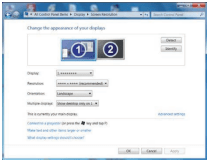
― To maximize the picture quality, it is recommended to use a graphics card that supports WQHD+ (3440 x 1440) resolution.
― When the PIP/PBP function is enabled, the resolution will not be able to automatically switch to the optimum resolution due to a compatibility issue between the graphics card and the Windows system. Set PIP/PBP Mode to Off. Alternatively, restart the monitor, then set the resolution to the optimum setting using the Windows interface.
Size
Select the size and aspect ratio of the sub-screen
 : Select the icon image if you want to use PBP mode where the optimum resolution for the left and right sides of the screen is 1720 x 1440 (width x height).
: Select the icon image if you want to use PBP mode where the optimum resolution for the left and right sides of the screen is 1720 x 1440 (width x height).
 : Select the icon image if you want to use PIP mode where the optimum resolution for the subscreen is 720 x 480 (width x height).
: Select the icon image if you want to use PIP mode where the optimum resolution for the subscreen is 720 x 480 (width x height).
 : Select the icon image if you want to use PIP mode where the optimum resolution of the subscreen is 1280 x 720 (width x height).
: Select the icon image if you want to use PIP mode where the optimum resolution of the subscreen is 1280 x 720 (width x height).
 : Select the icon image if you want to use PIP mode where the optimum resolution of the subscreen is 1720 x 720 (width x height).
: Select the icon image if you want to use PIP mode where the optimum resolution of the subscreen is 1720 x 720 (width x height).
Position
Select the position of the sub-screen from the available options.
― Not available when PBP is selected.
― The screen may flicker if the input signal is unstable.
Sound Source
Set which screen you want to hear the sound for.
PIP mode

PBP mode

Picture Size
PIP Mode (available in PIP mode (Size  /
/  /
/  ))
))
Select the image size for sub-screen.
In PC mode
• Auto: Display the picture according to the aspect ratio of the each screen input source.
• Wide: Display the picture in full screen regardless of the aspect ratio of the each screen input source.
In AV mode
• 4:3: Display the picture of the sub-screen with an aspect ratio of 4:3. Suitable for videos and standard broadcasts.
• 16:9: Display the picture of the sub-screen with an aspect ratio of 16:9.
• Screen Fit: Display the picture of the sub-screen with the original aspect ratio without cutting anything off.
― The function may not be supported depending on the ports provided with the product.
― Changing the screen size is available when the following conditions are satisfied.
― A digital output device is connected using the HDMI/DP cable.
― The input signal is 480p, 576p, 720p, or 1080p and monitor can display normally (Not every model can support all of these signals.).
― This can only be set when the external input is connected through HDMI/DP and PC/AV Mode is set to AV.
Chapter 06 Adjusting OSD (On Screen Display) settings
― The functions available may vary depending on the product model. The color and shape of parts may differ from what is shown. Specifications are subject to change without notice to improve quality.
Transparency
Set the transparency for the menu windows.
Position
Adjust the menu position.
Language
Set the menu language.
- A change to the language setting will only be applied to the onscreen menu display.
- It will not be applied to other functions on your PC.
Display Time
Set the on-screen display (OSD) menu to automatically disappear if the menu is not used for a specified period of time.
Display Time can be used to specify the time after which you want the OSD menu to disappear.
Chapter 07 Setup and Reset
FreeSync
FreeSync technology is solution that eliminates screen tearing without all the usual lag and latency.
This feature will eliminate screen tearing and lag during game play. Improve your gaming experience.
The displayed FreeSync menu items on the monitor may vary, depending on the monitor model and compatibility with the AMD graphics card.
― Not available when PIP/PBP Mode is set to On.
― The sound quality of the monitor may decrease if FreeSync is enabled.
- Off: Disable FreeSync.
- Standard Engine: Enable the basic FreeSync functions of the AMD graphics card.
- Ultimate Engine: Enable the FreeSync feature with a higher screen frame rate. Screen tearing (abnormal sync between the screen and content) is reduced in this mode. Note that screen flickering may occur during game play.
Apply the optimum resolution when using FreeSync.
The refresh rate setting method please refer to Q & A → How can I change the frequency?
― The FreeSync function is only enabled in HDMI2 or DisplayPort mode. Use the HDMI/DP cable provided by the manufacturer when using FreeSync.
If you use the FreeSync function while playing a game, the following symptoms may occur:
- The screen may flicker depending on the type of graphics card, the game option settings, or the video being played. Try the following actions: decrease the game setting values, change the current FreeSync mode to Standard Engine, or visit the AMD website to check your graphics driver’s version and update it with the latest one.
- While you are using the FreeSync function, the screen may flicker due to variation of the output frequency from the graphics card.
- The response rate during the game may fluctuate depending on the resolution. A higher resolution generally decreases the response rate.
- The sound quality of the monitor may be degraded.
― If you encounter any issues when using the function, contact the Samsung Service Center.
― When the resolution is changed while setting FreeSync to Standard Engine or Ultimate Engine, the screen tearing can happen intermittently. Set FreeSync to Off and change the resolution.
― The function is unavailable in the devices (e.g. AV devices) that have no AMD graphic card. If the function is applied, the screen may have malfunction.
The models in the Graphic Cards list supports FreeSync
FreeSync can only be used with specific AMD graphics card models. Refer to the following list for supported graphics cards:
Make sure to install the latest official graphics drivers from AMD that support FreeSync.
― For additional AMD graphics card models that support the FreeSync feature, visit the official AMD website.
― Select FreeSync Off if you are using a graphics card from a different manufacturer.
― When applying the FreeSync function via the HDMI interface, it may fail to work due to the bandwidth limitation of certain AMD display cards.
- AMD Radeon R9 300 Series
- AMD Radeon R9 Fury X
- AMD Radeon R7 360
- AMD Radeon R9 295X2
- AMD Radeon R9 290X
- AMD Radeon R9 290
- AMD Radeon R9 285
- AMD Radeon R7 260X
- AMD Radeon R7 260
- AMD Radeon RX 400 Series
- AMD Radeon RX 500 Series
- AMD RX VEGA Series
Eco Saving Plus
Reduce energy consumption compared to consumption at the maximum brightness level.
― This option is not available when  is in Dynamic Contrast mode.
is in Dynamic Contrast mode.
― This menu is not available when Game Mode is enabled.
― This menu is not available when Eye Saver Mode is enabled.
― Not available when PIP/PBP Mode is set to On.
- Off: Deactivate the Eco Saving Plus function.
- Auto: The power consumption will automatically be reduced by about 10% over the current setting. (The reduction of power consumption depends on the customer screen brightness condition.)
- Low: Saves up to 25 % energy compared to the maximum brightness.
- High: Saves up to 50 % energy compared to the maximum brightness.
Off Timer Plus
Configuring Off Timer
Off Timer: Turn on Off Timer mode
Turn Off After: The off timer can be set within a range of 1 to 23 hours. The product will automatically power off after the specified number of hours.
― This option is only available when Off Timer is set to On.
― For products for the market in some regions, the Off Timer is set to automatically activate 4 hours after the product powers on. This is done in accordance with power supply regulations. If you do not want the timer to activate, go to  → System → Off Timer Plus and set Off Timer to Off.
→ System → Off Timer Plus and set Off Timer to Off.
Configuring Eco Timer
Eco Timer: Turn on Eco Timer mode.
Eco Off After: The Eco Timer can be set between 10 and 180 minutes. The product will automatically power off after the specified time has elapsed.
― This option is only available when Eco Timer is set to On.
PC/AV Mode
Set PC/AV Mode to AV. The picture size will be enlarged.
This option is useful when you view a movie.
- Set to PC when connected to a PC.
- Set to AV when connected to an AV device.
If the monitor (when set to HDMI1, HDMI2, DisplayPort) is in power saving mode or is displaying the message Check Signal Cable, press the  icon to display the On Screen Display (OSD). You can select PC or AV.
icon to display the On Screen Display (OSD). You can select PC or AV.
DisplayPort Ver.
Select your Displayport.
- Incorrect settings may cause the screen to go blank. If this occurs, check the device specifications.
- If the monitor (when set to HDMI1, HDMI2, DisplayPort) is in power saving mode or is displaying the message Check Signal Cable, press the icon to display the On Screen Display (OSD). You can select 1.1 or 1.2.
Source Detection
Select either Auto or Manual as the method to recognize input signal.
- Not available when PIP/PBP Mode is set to On.
Key Repeat Time
Control the response rate of a button when the button is pressed.
Acceleration, 1 sec, or 2 sec can be selected. If No Repeat is selected, a command responds only once when a button is pressed.
Power LED On
Configure the settings to enable or disable the power LED located at the lower part of the product.
- Working: The power LED is on when the product is turned on.
- Stand-by: The power LED is on when the product is turned off.
Reset All
Return all the settings for the product to the default factory settings.
Information
View the current input source, frequency and resolution
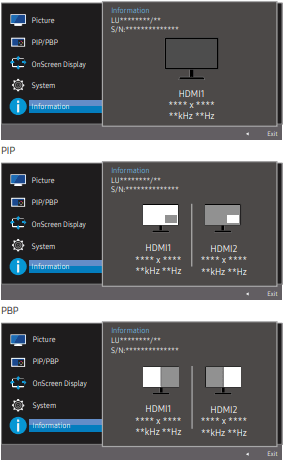
Chapter 08 Installing the Software
Easy Setting Box

Easy Setting Box enables users to use the monitor by partitioning multiple sections. To install the latest version of Easy Setting Box, download it from the Samsung Electronics website.
― The software may not work properly if you do not restart the computer after the installation.
― The Easy Setting Box icon may not appear depending on the computer system and the product specifications.
― If the shortcut icon does not appear, press the F5 key.
Chapter 09 Troubleshooting Guide
Testing the Product
Check if your product is operating normally by using the product test function.
If the screen is turned off and the power indicator blinks even though the product is properly connected to a PC, perform a self-diagnosis test.
- Power off both the PC and product.
- Disconnect the cables from the product.
- Power on the product.
- If the message Check Signal Cable appears, the product is working normally.
If the screen remains blank, check the PC system, video controller and cable.
Checking the Resolution and Frequency
For a mode that exceeds the supported resolution(refer to Standard Signal Mode Table), the message Not Optimum Mode will appear for a short time.
― The displayed resolution may vary, depending on the computer system settings and cables.
Check the following.
Installation issue (PC mode)
The screen keeps switching on and off.
Check the cable connection between the product and PC, and ensure the connectors are locked.
Blank spaces are found on all four sides of the screen when an HDMI or HDMI-DVI cable is connected to the product and PC.
The blank spaces found on the screen have nothing to do with the product.
Blank spaces on the screen are caused by the PC or graphics card. To resolve the problem, adjust the screen size in the HDMI or DVI settings for the graphics card.
If the graphics card settings menu does not have an option to adjust the screen size, update the graphics card driver to the latest version.
(Please contact the graphics card or computer manufacturer for further details about how to adjust the screen settings.)
Screen issue
The power LED is off. The screen will not switch on.
Check that the power cable is connected properly
The message Check Signal Cable appears.
Check that the cable is properly connected to the product.
Check that the device connected to the product is powered on
Not Optimum Mode is displayed
This message appears when the signal from the graphics card exceeds the maximum resolution or frequency for the product.
Change the maximum resolution and frequency to suit the product performance, referring to Standard Signal Mode Table (P.45).
The images on the screen look distorted.
Check the cable connection to the product.
The screen is not clear. The screen is blurry.
Remove any accessories (video extension cable, etc.) and try again.
Set the resolution and frequency to the recommended level.
The screen appears unstable and shaky. There are shadows or ghost images left on the screen.
Check that the resolution and frequency for the PC are within the range of resolution and frequency compatible with the product. Next, if required, change the settings, referring to Standard Signal Mode Table (P.45) in this manual and the Information menu on the product.
The screen is too bright. The screen is too dark.
Adjust Brightness and Contrast.
Screen color is inconsistent.
Change the Color settings.
The colors on the screen have a shadow and are distorted.
Change the Color settings.
White does not really look white.
Change the Color settings.
There is no image on the screen and the power LED blinks every 0.5 to 1 second.
The product is operating in power-saving mode.
Press any key on the keyboard or move the mouse to return to normal operating mode.
Text is blurry.
If using a Windows OS (e.g. Windows 7, Windows 8, Windows 8.1 or Windows 10): Go to Control Panel → Fonts → Adjust ClearType text and change Turn on ClearType.
Video playback is choppy.
Playback of high-definition large video files can be choppy. This may be because the video player is not optimized for the computer resource.
Try playing the file on another video player
Sound issue
There is no sound.
Check the connection of the audio cable or adjust the volume.
Check the volume.
The volume is too low.
Adjust the volume.
If the volume is still low after turning it up to the maximum level, adjust the volume on your PC sound card or software program.
Video is available but there is no sound.
Sound cannot be heard if a HDMI-DVI cable is used to connect the input device.
Connect the device using an HDMI cable or DP cable.
Source device issue
A beeping sound is heard when my PC is booting.
If a beeping sound is heard when your PC is booting, have your PC serviced.
Q & A
How can I change the frequency?
Set the frequency on your graphics card.
- Windows 7: Go to Control Panel → Appearance and Personalization → Display → Screen Resolution → Advanced settings → Monitor, and adjust Refresh rate under Monitor settings.
- Windows 8(Windows 8.1): Go to Settings → Control Panel → Appearance and Personalization → Display → Screen Resolution → Advanced settings → Monitor, and adjust Refresh rate under Monitor settings.
- Windows 10: Go to Settings → System → Display → Advanced display settings → Display adapter properties → Monitor, and adjust Screen refresh rate under Monitor settings.
How can I change the resolution?
- Windows 7: Go to Control Panel → Appearance and Personalization → Display → Adjust Resolution, and adjust the resolution.
- Windows 8(Windows 8.1): Go to Settings → Control Panel → Appearance and Personalization → Display → Adjust Resolution, and adjust the resolution.
- Windows 10: Go to Settings → System → Display → Advanced display settings, and adjust the resolution.
How do I set power-saving mode?
- Windows 7: Set power-saving mode in Control Panel → Appearance and Personalization → Personalize → Screen Saver Settings → Power options or BIOS SETUP on the PC.
- Windows 8(Windows 8.1): Set power-saving mode in Settings → Control Panel → Appearance and Personalization → Personalize → Screen Saver Settings → Power options or BIOS SETUP on the PC.
- Windows 10: Set power-saving mode in Settings → Personalization → Lock screen → Screen timeout settings → Power & sleep or BIOS SETUP on the PC.
See other models: NP550XTA-K01US 8.0", XE500C13-K04US LC49HG90DMNXZA LC27F591FDNXZA

